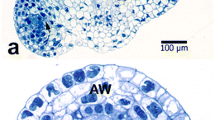Summary
Ultrastructural changes of pollen cytoplasm during generative cell formation and pollen maturation inArabidopsis thaliana were studied. The pollen cytoplasm develops a complicated ultra-structure and changes dramatically during these stages. Lipid droplets increase after generative cell formation and their organization and distribution change with the developmental stage. Starch grains in amyloplasts increase in number and size during generative and sperm cell formation and decrease at pollen maturity. The shape and membrane system of mitochondria change only slightly. Dictyo-somes become very prominent, and numerous associated vesicles are observed during and after sperm cell formation. Endoplasmic reticulum appears extensively as stacks during sperm cell formation. Free and polyribosomes are abundant in the cytoplasm at all developmental stages although they appear denser at certain stages and in some areas. In mature pollen, all organelles are randomly distributed throughout the vegetative cytoplasm and numerous small particles appear. Organization and distribution of storage substances and appearance of these small particles during generative and sperm cell formation and pollen maturation are discussed.
Similar content being viewed by others
References
Charzynska M, Murgia M, Cresti M (1989) Ultrastructure of the vegetative cell ofBrassica napus pollen with particular reference to microbodies. Protoplasma 152: 22–28
Cresti M, Pacini E, Ciampolini F, Sarfatti G (1977) Germination and early tube development in vitro ofLycopersicum peruvianum pollen: ultrastructural features. Planta 136: 239–247
Dahl OA (1986) Observation on pollen development inArabidopsis under gravitationally controlled environments. In: Blackmore S, Ferguson IK (eds) Pollen and spores: form and function. Academic Press, Orlando, pp 49–59 (Linnean Society symposium series, United States edition)
Dawson J, Wilson ZA, Aarts MGM, Braithwaite AF, Briarty LG, Mulligan BJ (1992) Microspore and pollen development in six male-sterile mutants ofArabidopsis thaliana. Can J Bot 71: 629–638
Heslop-Harrison J (1979) Aspects of the structure, cytochemistry, and germination of the pollen of rye. Ann Bot 44 Suppl 1: 1–47
—, Heslop-Harrison Y (1982) The growth of the grass pollen tube: 1. Characteristics of the polysaccharide particles (“P-particles”) associated with apical growth. Protoplasma 112: 71–80
— —, Shivanna KR (1984) The evaluation of pollen quality, and a further appraisal of the fluorochromatic (FCR) test procedure. Theor Appl Genet 67: 367–375
Kordyum EL, Sytnik KM, Chernyaeva II (1983) Peculiarities of genital organ formation inArabidopsis thaliana (L.) Heynh. under spaceflight conditions. Adv Space Res 3: 247–250
Kuang A, Musgrave ME, Matthews SW, Cummins DB, Tucker SC (1995) Pollen and ovule development inArabidopsis thaliana under spaceflight conditions. Am J Bot 82: 585–595
McCormick S (1993) Male gametophyte development. Plant Cell 5: 1265–1275
Murgia M, Detchepare S, Van Went JL, Cresti M (1991)Brassica napus pollen development during generative cell and sperm cell formation. Sex Plant Reprod 4: 176–181
Musgrave ME, Cummins DB, Matthews SW, Kuang A, Daugherty CJ, Porterfield DM (1993) Growth and flowering ofArabidopsis thaliana during spaceflight. Am Soc Gravit Space Biol Bull 7: 83
Preuss D, Lemieux B, Yen D, Davis RD (1993) A conditional sterile mutation eliminates surface components fromArabidopsis pollen and disrupts cell signaling during fertilization. Genes Dev 7: 974–985
Regan SM, Moffatt BA (1990) Cytochemical analysis of pollen development in wild-typeArabidopsis and a maleysterile mutant. Plant Cell 2: 877–889
Reiss HD, McConchie CA (1988) Studies ofNajas pollen tubes. Fine structure and the dependence of chlortetracycline fluorescence on external free ions. Protoplasma 142: 25–35
Sanger JM, Jackson WT (1971) Fine structure study of pollen development inHaemanthus katherinae Baker. J Cell Sci 8: 289–301
Spurr AR (1969) A low viscosity epoxy resin embedding medium for electron microscopy. J Ultrastruct Res 26: 31–43
Thiery JP (1967) Mise en évidence de polysaccharides sur coupes fines en microscopie électronique. J Microsc 6: 987–1018
VanDer Woude WJ, Morre DJ, Bracker CE (1971) Isolation and characterization of secretory vesicles in germinated pollen ofLilium longiflorum. J Cell Sci 8: 331–351
Weber M (1988) Metabolism of P-particles (polysaccharide particles) in mature pollen grains ofEryngium campestre L. (Apiaceae). Protoplasma 146: 65–71
— (1989) Ultrastructural changes in maturing pollen grains ofApium nodiflorum L. (Apiaceae), with special reference to the endoplasmic reticulum. Protoplasma 152: 69–76
Author information
Authors and Affiliations
Rights and permissions
About this article
Cite this article
Kuang, A., Musgrave, M.E. Dynamics of vegetative cytoplasm during generative cell formation and pollen maturation inArabidopsis thaliana . Protoplasma 194, 81–90 (1996). https://doi.org/10.1007/BF01273170
Received:
Accepted:
Issue Date:
DOI: https://doi.org/10.1007/BF01273170




